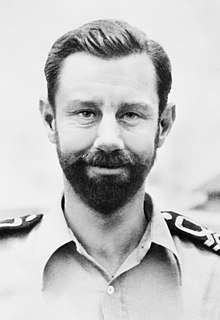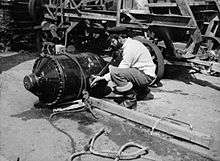George Gosse
Lieutenant Commander George Gosse, GC (16 February 1912 – 31 December 1964) was an Australian recipient of the George Cross, the highest award for heroism or courage, not in the face of the enemy, that could be awarded to a member of the Australian armed forces at the time. Gosse served in the Royal Australian Navy between 1926 and 1933, reaching the rank of sub-lieutenant and receiving training and experience with the Royal Navy. In 1940, he joined the Royal Australian Naval Volunteer Reserve (RANVR) for service in World War II. Quickly sent back to the United Kingdom, he served on several shore establishments before being sent to British India as a naval mine clearance specialist. He returned to the UK in late 1944, and in April 1945 he was given command of a naval party responsible for mine clearance in the recently captured Bremen Harbour in Germany. He displayed courage in defusing three mines under very difficult conditions between 8 May and 19 May 1945, which resulted in him being awarded the George Cross.
Lieutenant Commander George Gosse GC | |
|---|---|
 Lieutenant George Gosse c.1945 | |
| Born | 16 February 1912 Harvey, Western Australia |
| Died | 31 December 1964 (aged 52) Maslin Beach, South Australia |
| Allegiance | Australia |
| Service/ | Royal Australian Navy |
| Years of service | 1926–1933 1940–1946 |
| Rank | Lieutenant Commander |
| Battles/wars | Second World War
|
| Awards | George Cross |
Gosse continued to serve in the RANVR after the war, reaching the rank of lieutenant commander before retiring in 1958, and died of a heart condition in 1964. His medal set is displayed in the Hall of Valour at the Australian War Memorial.
Early life and career
George Gosse was born on 16 February 1912 at Harvey, Western Australia, the eldest child of William Hay Gosse, a farmer, and his wife Muriel née Davidson. He was a grandson of the explorer William Gosse and a nephew of the businessman Sir James Hay Gosse. His father had served in the 2nd South Australian Mounted Rifles in the Second Boer War, and joined the British Army as an artillery officer in World War I. He was awarded the Military Cross for gallantry and was killed in action in 1918. Muriel died in 1920; George and his younger sister were then cared for by their paternal grandmother.[1][2][3]
Gosse was schooled at St Peter's College, Adelaide, South Australia, and entered the Royal Australian Naval College (RAN College) at Jervis Bay in 1926.[1][2] According to a family member he was "so like his father, gay, feckless, fearless and gregarious".[1] While at the RAN College he excelled at field hockey, and upon graduation received the prize for engineering theory. Beginning in January 1930 he served aboard both Australian County-class heavy cruisers, first HMAS Australia then HMAS Canberra. He was promoted to midshipman in May of that year. In July 1931, he sailed for the United Kingdom for further training with the Royal Navy.[1][2]
His first assignment was to the Mediterranean Fleet, aboard the Revenge-class super-dreadnought battleship HMS Ramillies. He also attended an air course on the Courageous-class aircraft carrier HMS Glorious, and was familiarised with the employment of destroyers during a stint aboard HMS Worcester.[1] In September 1932 he was promoted to acting sub-lieutenant,[2][4] and entered the Royal Naval College, Greenwich. The social and sporting temptations of London beckoned, and Gosse's studies suffered. After he failed the examination for lieutenant, he was returned to Australia and his naval career ended on 30 October 1933. Gosse then worked at odd jobs for a few years, and in 1938 he married Diana Skottowe at his old school chapel.[1] The couple had two daughters.[2]
World War II
On 21 October 1940, Gosse enlisted as an ordinary seaman in the Royal Australian Naval Volunteer Reserve.[1] He initially underwent training at the shore establishments HMAS Torrens and HMAS Cerberus, before sailing for the UK in December. In April 1941 he was commissioned as a sub-lieutenant while posted to the shore establishment HMS King Alfred. In December of that year he was transferred to the Royal Indian Navy shore establishment HMIS Hooghly in Calcutta, British India, as a naval mine disposal officer. In August of that year, he was transferred to HMS Lanka, and in February 1942 he was promoted to provisional lieutenant. This was followed by a posting to the shore establishment HMS Braganza in Bombay in October 1942.[1][2][5] His annual reports indicate that he was reliable and keen, and displayed ingenuity. When faced with difficulties, he was always cheerful, and was "a daring character" who was very interested in mines.[1]

Transferred back to the UK in November 1944,[2] Gosse was posted to the shore establishment HMS Vernon at Brixham, Devon, which was the European port clearance diving base for the Royal Navy.[1] Clearance diving teams were responsible for removing naval mines from British waters, and from the waters of captured ports on the European mainland.[6] He brought a Japanese mine back with him to the UK, as he considered it would be of use at HMS Vernon.[7] He was a bit of a law unto himself in this period, but was fascinated with mechanical devices and exhibited inventiveness. He qualified as a shallow-water diver in January 1945.[1]
Following the capture of Bremen, Germany, in April, Gosse led Naval Party 1571 to the port to clear mines laid by the retreating Germans in the Überseehafen. After arriving in Bremen, Gosse risked his life many times in defusing mines. When his divers reported a sighting of what appeared to be a new form of mine, on 8 May Gosse dived himself and verified that it was a "D-type mine with additional fittings", known as an "Oyster". This mine was pressure-operated, and its detonation train included magnetic and acoustic elements. About 18:00 the next day, Gosse examined the mine by touch, as the visibility was so poor that his waterproof torch was of no use. In order to maintain his depth, he had to tether himself to the mine marker buoy rope. Using tools he had improvised, Gosse interrupted the detonation train by removing the primer release and the primer, which had to be extracted from about 18 inches (460 mm) down a 2-inch (51 mm) wide tube. Having made the mine safe, Gosse was releasing his tether when there was a small explosion. Later examination of the mine showed that water had entered the primer tube and actuated a water pressure trigger set to go off if the mine was raised. Gosse personally defused two more "Oyster" mines at Bremen between 9 and 19 May. He was promoted to acting lieutenant commander on 30 September 1945, and was demobilised on 20 March 1946.[1][8] For his service in World War II, Gosse was awarded the 1939–1945 Star, the Burma Star, the France and Germany Star, the Defence Medal, the War Medal 1939–1945, and the Australia Service Medal 1939–1945.[9]

On 26 April 1946, Gosse's award of the George Cross was promulgated in The London Gazette. The citation read:[10]
On the 8th May 1945, divers searching Ubersee Hafen reported the presence of a mine which from their description appeared to be an entirely new type. Lieutenant Gosse immediately dived and verified the fact that it was a G.D. pressure type which was commonly known as "Oyster". As it was very necessary that this type of mine should be recovered intact, it was decided to attempt to render safe the mine underwater and on the following day, May 9th, Lieutenant Gosse dived on it again. Using improvised tools he eventually succeeded in removing the primer, which was followed by a loud metallic crash. The mine was eventually lifted on the quayside when it was found that the detonator had fired immediately the primer had been removed. During the subsequent ten days, Lieutenant Gosse rendered safe two similar types of mines which were lying in close proximity to shipping and in each instance the detonator fired before the mine reached the surface.
This form of operation called for exceptionally high standard of personal courage and also a high degree of skill. The conditions were always arduous and were combined with the presence of known mines in the docks and with all forms of underwater obstruction—human corpses—which together with lack of visibility produced a set of conditions which would deter the boldest.
This officer displayed courage and zeal far in excess of the usual course of duty and contributed greatly to the success of a most difficult and important operation.— The London Gazette 26 April 1946
Later life
Gosse was invested with his George Cross in Adelaide on 3 June 1948 by the Governor of South Australia, Lieutenant General Sir Willoughby Norrie. He continued to serve in the RANVR, and was substantively promoted to lieutenant commander on 30 June 1955 before retiring in 1958.[2] He remained inventive, creating many useful domestic gadgets and fittings, but his interest waned once a challenge had been met. His work was mostly "unspectacular". He was president of the Sporting Car Club of South Australia from 1946 to 1948.[1]
During 1950, Gosse was part of an armed forces recruiting campaign throughout South Australia, before collapsing from nervous strain at a rally in Renmark.[11] In 1953 he was part of the contingent sent to the UK for the coronation of Queen Elizabeth II,[1] and was awarded the Queen Elizabeth II Coronation Medal.[9] Gosse died of a coronary occlusion at Maslin Beach on 31 December 1964, and was cremated.[1] He is commemorated on the Returned and Services League Walls at the Centennial Park Cemetery.[12]
His medal set is displayed in the Hall of Valour at the Australian War Memorial.[9] A ward at the former Repatriation General Hospital, Hollywood in Western Australia (now Hollywood Private Hospital) has been named in his honour.[13]
Footnotes
- Crawford 1996.
- Staunton 2005, p. 313.
- Australian War Memorial 2019a.
- National Archives 2019, p. 2.
- National Archives 2019, p. 4.
- Grey 1998, p. 280.
- Firkins 1983, p. 116.
- Turner 2010, pp. 112–113.
- Australian War Memorial 2019b.
- "No. 37549". The London Gazette (1st supplement). 26 April 1946. p. 2085.
- The Border Watch 7 December 1950.
- Department of Veterans' Affairs 2019.
- Hollywood Private Hospital 2019.
References
- "A History of Caring". Hollywood Private Hospital. Retrieved 9 May 2019.
- Crawford, I. McL. (1996). "Gosse, George (1912–1964)". Australian Dictionary of Biography. Canberra: Australian National University. Retrieved 8 May 2019.CS1 maint: ref=harv (link)
- Firkins, Peter C. (1983). Of Nautilus and Eagles: History of the Royal Australian Navy. Richmond, Victoria: Hutchinson. ISBN 978-0-09-148290-9.CS1 maint: ref=harv (link)
- "George Cross : Lieutenant G Gosse, Royal Australian Naval Volunteer Reserve". Australian War Memorial. Retrieved 8 May 2019.
- "Gosse, George Lieutenant Commander". Department of Veterans' Affairs. Retrieved 9 May 2019.
- Grey, Jeffrey (1998). Up Top: the Royal Australian Navy and Southeast Asian conflicts, 1955–1972. The Official History of Australia's Involvement in Southeast Asian Conflicts 1948–1975. St. Leonards, NSW: Allen & Unwin. ISBN 1-86448-290-7.
- "NAA: A6769, Gosse G". National Archives of Australia. Retrieved 8 May 2019.
- "Pre First World War Conflicts Nominal Rolls: William Hay Gosse". Australian War Memorial. Retrieved 9 May 2019.
- "Recruiting Speaker Collapses". The Border Watch. 90 (10, 241). South Australia. 7 December 1950. p. 13. Retrieved 31 July 2019.
- Staunton, Anthony (2005). Victoria Cross: Australia's Finest and the Battles they Fought. Prahran, Victoria: Hardie Grant. ISBN 978-1-74273-486-6.CS1 maint: ref=harv (link)
- Turner, John Frayn (2010). Awards of the George Cross 1940-2009. Barnsley, UK: Casemate Publishers. ISBN 978-1-84884-200-7.CS1 maint: ref=harv (link)